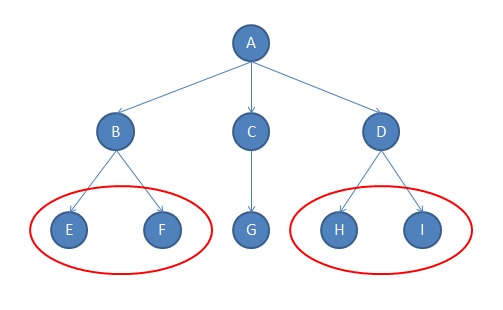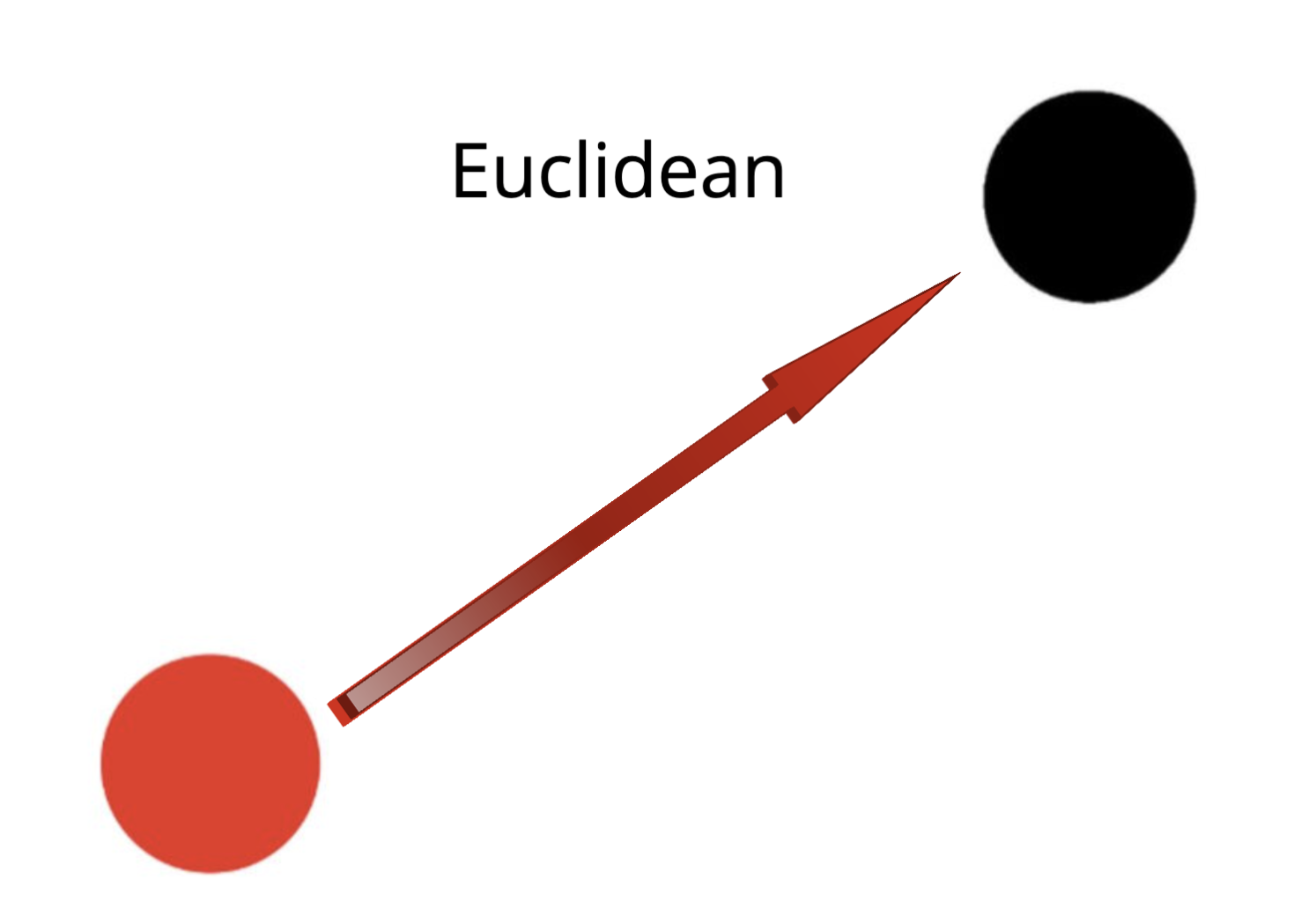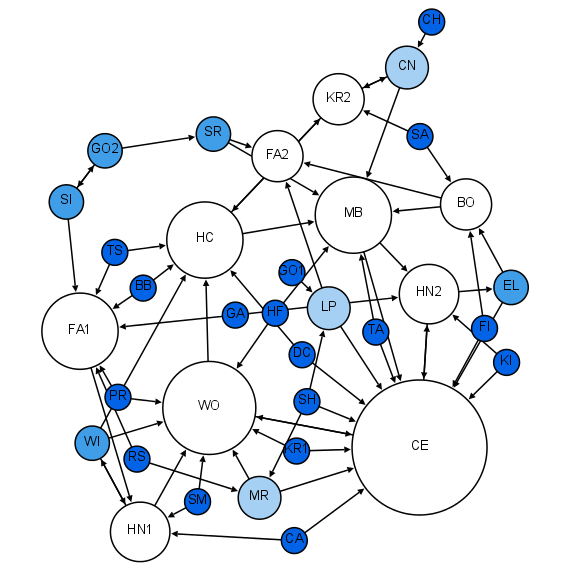 |
Similarity (network Science)
Similarity in network analysis occurs when two nodes (or other more elaborate structures) fall in the same equivalence class. There are three fundamental approaches to constructing measures of network similarity: structural equivalence, automorphic equivalence, and regular equivalence.Newman, M.E.J. 2010. ''Networks: An Introduction.'' Oxford, UK: Oxford University Press. There is a hierarchy of the three equivalence concepts: any set of structural equivalences are also automorphic and regular equivalences. Any set of automorphic equivalences are also regular equivalences. Not all regular equivalences are necessarily automorphic or structural; and not all automorphic equivalences are necessarily structural. Visualizing similarity and distance Clustering tools Agglomerative Hierarchical clustering of nodes on the basis of the similarity of their profiles of ties to other nodes provides a joining tree or Dendrogram that visualizes the degree of similarity among cases - and c ... [...More Info...] [...Related Items...] OR: [Wikipedia] [Google] [Baidu] [Amazon] |
 |
Hierarchical Clustering
In data mining and statistics, hierarchical clustering (also called hierarchical cluster analysis or HCA) is a method of cluster analysis that seeks to build a hierarchy of clusters. Strategies for hierarchical clustering generally fall into two categories: * Agglomerative: Agglomerative: Agglomerative clustering, often referred to as a "bottom-up" approach, begins with each data point as an individual cluster. At each step, the algorithm merges the two most similar clusters based on a chosen distance metric (e.g., Euclidean distance) and linkage criterion (e.g., single-linkage, complete-linkage). This process continues until all data points are combined into a single cluster or a stopping criterion is met. Agglomerative methods are more commonly used due to their simplicity and computational efficiency for small to medium-sized datasets . * Divisive: Divisive clustering, known as a "top-down" approach, starts with all data points in a single cluster and recursively splits the clu ... [...More Info...] [...Related Items...] OR: [Wikipedia] [Google] [Baidu] [Amazon] |
|
Dendrogram
A dendrogram is a diagram representing a Tree (graph theory), tree graph. This diagrammatic representation is frequently used in different contexts: * in hierarchical clustering, it illustrates the arrangement of the clusters produced by the corresponding analyses. * in computational biology, it shows the clustering of genes or samples, sometimes in the margins of heat map, heatmaps. * in phylogenetics, it displays the evolutionary relationships among various biological taxa. In this case, the dendrogram is also called a phylogenetic tree. The name ''dendrogram'' derives from the two ancient greek words (), meaning "tree", and (), meaning "drawing, mathematical figure". Clustering example For a clustering example, suppose that five taxa (a to e) have been clustered by UPGMA based on a matrix of genetic distances. The hierarchical clustering dendrogram would show a column of five nodes representing the initial data (here individual taxa), and the remaining nodes repre ... [...More Info...] [...Related Items...] OR: [Wikipedia] [Google] [Baidu] [Amazon] |
|
 |
Structural Equivalence
Similarity in network analysis occurs when two nodes (or other more elaborate structures) fall in the same equivalence class. There are three fundamental approaches to constructing measures of network similarity: structural equivalence, automorphic equivalence, and regular equivalence.Newman, M.E.J. 2010. ''Networks: An Introduction.'' Oxford, UK: Oxford University Press. There is a hierarchy of the three equivalence concepts: any set of structural equivalences are also automorphic and regular equivalences. Any set of automorphic equivalences are also regular equivalences. Not all regular equivalences are necessarily automorphic or structural; and not all automorphic equivalences are necessarily structural. Visualizing similarity and distance Clustering tools Agglomerative Hierarchical clustering of nodes on the basis of the similarity of their profiles of ties to other nodes provides a joining tree or Dendrogram that visualizes the degree of similarity among cases - and c ... [...More Info...] [...Related Items...] OR: [Wikipedia] [Google] [Baidu] [Amazon] |
|
Cosine Similarity
In data analysis, cosine similarity is a measure of similarity between two non-zero vectors defined in an inner product space. Cosine similarity is the cosine of the angle between the vectors; that is, it is the dot product of the vectors divided by the product of their lengths. It follows that the cosine similarity does not depend on the magnitudes of the vectors, but only on their angle. The cosine similarity always belongs to the interval 1, +1 For example, two proportional vectors have a cosine similarity of +1, two orthogonal vectors have a similarity of 0, and two opposite vectors have a similarity of −1. In some contexts, the component values of the vectors cannot be negative, in which case the cosine similarity is bounded in ,1/math>. For example, in information retrieval and text mining, each word is assigned a different coordinate and a document is represented by the vector of the numbers of occurrences of each word in the document. Cosine similarity then gives a u ... [...More Info...] [...Related Items...] OR: [Wikipedia] [Google] [Baidu] [Amazon] |
|
 |
Similarity Measure
In statistics and related fields, a similarity measure or similarity function or similarity metric is a real-valued function that quantifies the similarity between two objects. Although no single definition of a similarity exists, usually such measures are in some sense the inverse of distance metrics: they take on large values for similar objects and either zero or a negative value for very dissimilar objects. Though, in more broad terms, a similarity function may also satisfy metric axioms. Cosine similarity is a commonly used similarity measure for real-valued vectors, used in (among other fields) information retrieval to score the similarity of documents in the vector space model. In machine learning, common kernel functions such as the RBF kernel can be viewed as similarity functions. Use of different similarity measure formulas Different types of similarity measures exist for various types of objects, depending on the objects being compared. For each type of object there ... [...More Info...] [...Related Items...] OR: [Wikipedia] [Google] [Baidu] [Amazon] |
|
Pearson Product-moment Correlation Coefficient
In statistics, the Pearson correlation coefficient (PCC) is a correlation coefficient that measures linear correlation between two sets of data. It is the ratio between the covariance of two variables and the product of their standard deviations; thus, it is essentially a normalized measurement of the covariance, such that the result always has a value between −1 and 1. As with covariance itself, the measure can only reflect a linear correlation of variables, and ignores many other types of relationships or correlations. As a simple example, one would expect the age and height of a sample of children from a school to have a Pearson correlation coefficient significantly greater than 0, but less than 1 (as 1 would represent an unrealistically perfect correlation). Naming and history It was developed by Karl Pearson from a related idea introduced by Francis Galton in the 1880s, and for which the mathematical formula was derived and published by Auguste Bravais in 1844. The naming ... [...More Info...] [...Related Items...] OR: [Wikipedia] [Google] [Baidu] [Amazon] |
|
|
Euclidean Distance
In mathematics, the Euclidean distance between two points in Euclidean space is the length of the line segment between them. It can be calculated from the Cartesian coordinates of the points using the Pythagorean theorem, and therefore is occasionally called the Pythagorean distance. These names come from the ancient Greek mathematicians Euclid and Pythagoras. In the Greek deductive geometry exemplified by Euclid's ''Elements'', distances were not represented as numbers but line segments of the same length, which were considered "equal". The notion of distance is inherent in the compass tool used to draw a circle, whose points all have the same distance from a common center point. The connection from the Pythagorean theorem to distance calculation was not made until the 18th century. The distance between two objects that are not points is usually defined to be the smallest distance among pairs of points from the two objects. Formulas are known for computing distances b ... [...More Info...] [...Related Items...] OR: [Wikipedia] [Google] [Baidu] [Amazon] |
|
|
Automorphic Equivalence
Automorphic may refer to *Automorphic number, in mathematics *Automorphic form, in mathematics * Automorphic representation, in mathematics * Automorphic L-function, in mathematics *Automorphism In mathematics, an automorphism is an isomorphism from a mathematical object to itself. It is, in some sense, a symmetry of the object, and a way of mapping the object to itself while preserving all of its structure. The set of all automorphism ..., in mathematics * Rock microstructure#Crystal shapes {{disambig ... [...More Info...] [...Related Items...] OR: [Wikipedia] [Google] [Baidu] [Amazon] |
|
|
Regular Equivalence
Regular may refer to: Arts, entertainment, and media Music * "Regular" (Badfinger song) * Regular tunings of stringed instruments, tunings with equal intervals between the paired notes of successive open strings Other uses * Regular character, a main character who appears more frequently and/or prominently than a recurring character * Regular division of the plane, a series of drawings by the Dutch artist M. C. Escher which began in 1936 Language * Regular inflection, the formation of derived forms such as plurals in ways that are typical for the language ** Regular verb * Regular script, the newest of the Chinese script styles Mathematics Algebra and number theory * Regular category, a kind of category that has similarities to both Abelian categories and to the category of sets * Regular chains in computer algebra * Regular element (other), certain kinds of elements of an algebraic structure * Regular extension of fields * Regular ideal (multiple definitions) ... [...More Info...] [...Related Items...] OR: [Wikipedia] [Google] [Baidu] [Amazon] |
|
 |
Similarity Measure
In statistics and related fields, a similarity measure or similarity function or similarity metric is a real-valued function that quantifies the similarity between two objects. Although no single definition of a similarity exists, usually such measures are in some sense the inverse of distance metrics: they take on large values for similar objects and either zero or a negative value for very dissimilar objects. Though, in more broad terms, a similarity function may also satisfy metric axioms. Cosine similarity is a commonly used similarity measure for real-valued vectors, used in (among other fields) information retrieval to score the similarity of documents in the vector space model. In machine learning, common kernel functions such as the RBF kernel can be viewed as similarity functions. Use of different similarity measure formulas Different types of similarity measures exist for various types of objects, depending on the objects being compared. For each type of object there ... [...More Info...] [...Related Items...] OR: [Wikipedia] [Google] [Baidu] [Amazon] |
 |
Blockmodeling
Blockmodeling is a set or a coherent Conceptual framework, framework, that is used for analyzing social structure and also for setting procedure(s) for partitioning (clustering) social network's units (Node (computer science), nodes, vertices, social actor, actors), based on specific patterns, which form a distinctive structure through interconnectivity.Patrick Doreian, An Intuitive Introduction to Blockmodeling with Examples, ''BMS: Bulletin of Sociological Methodology'' / ''Bulletin de Méthodologie Sociologique'', January, 1999, No. 61 (January, 1999), pp. 5–34. It is primarily used in statistics, machine learning and network science. As an empirical procedure, blockmodeling assumes that all the units in a specific network can be grouped together to such extent to which they are equivalent. Regarding equivalency, it can be structural, regular or generalized.Anuška Ferligoj: Blockmodeling, http://mrvar.fdv.uni-lj.si/sola/info4/nusa/doc/blockmodeling-2.pdf Using blockmodeling, ... [...More Info...] [...Related Items...] OR: [Wikipedia] [Google] [Baidu] [Amazon] |
 |
Network Science
Network science is an academic field which studies complex networks such as telecommunication networks, computer networks, biological networks, Cognitive network, cognitive and semantic networks, and social networks, considering distinct elements or actors represented by ''nodes'' (or ''vertices'') and the connections between the elements or actors as ''links'' (or ''edges''). The field draws on theories and methods including graph theory from mathematics, statistical mechanics from physics, data mining and information visualization from computer science, inferential statistics, inferential modeling from statistics, and social structure from sociology. The United States National Research Council defines network science as "the study of network representations of physical, biological, and social phenomena leading to predictive models of these phenomena." Background and history The study of networks has emerged in diverse disciplines as a means of analyzing complex relational ... [...More Info...] [...Related Items...] OR: [Wikipedia] [Google] [Baidu] [Amazon] |